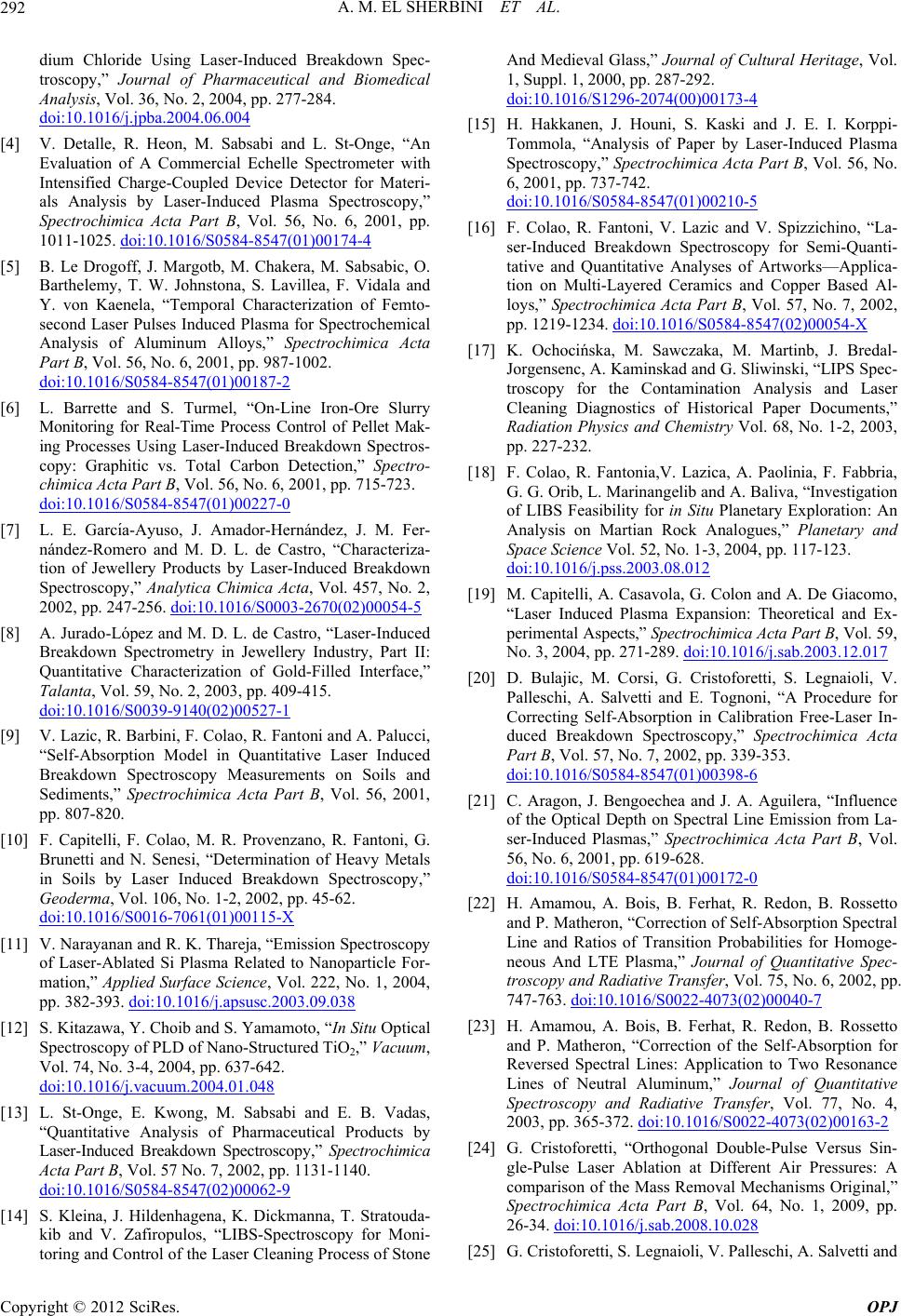
A. M. EL SHERBINI ET AL.
292
dium Chloride Using Laser-Induced Breakdown Spec-
troscopy,” Journal of Pharmaceutical and Biomedical
Analysis, Vol. 36, No. 2, 2004, pp. 277-284.
doi:10.1016/j.jpba.2004.06.004
[4] V. Detalle, R. Heon, M. Sabsabi and L. St-Onge, “An
Evaluation of A Commercial Echelle Spectrometer with
Intensified Charge-Coupled Device Detector for Materi-
als Analysis by Laser-Induced Plasma Spectroscopy,”
Spectrochimica Acta Part B, Vol. 56, No. 6, 2001, pp.
1011-1025. doi:10.1016/S0584-8547(01)00174-4
[5] B. Le Drogoff, J. Margotb, M. Chakera, M. Sabsabic, O.
Barthelemy, T. W. Johnstona, S. Lavillea, F. Vidala and
Y. von Kaenela, “Temporal Characterization of Femto-
second Laser Pulses Induced Plasma for Spectrochemical
Analysis of Aluminum Alloys,” Spectrochimica Acta
Part B, Vol. 56, No. 6, 2001, pp. 987-1002.
doi:10.1016/S0584-8547(01)00187-2
[6] L. Barrette and S. Turmel, “On-Line Iron-Ore Slurry
Monitoring for Real-Time Process Control of Pellet Mak-
ing Processes Using Laser-Induced Breakdown Spectros-
copy: Graphitic vs. Total Carbon Detection,” Spectro-
chimica Acta Part B, Vol. 56, No. 6, 2001, pp. 715-723.
doi:10.1016/S0584-8547(01)00227-0
[7] L. E. Garcı́a-Ayuso, J. Amador-Hernández, J. M. Fer-
nández-Romero and M. D. L. de Castro, “Characteriza-
tion of Jewellery Products by Laser-Induced Breakdown
Spectroscopy,” Analytica Chimica Acta, Vol. 457, No. 2,
2002, pp. 247-256. doi:10.1016/S0003-2670(02)00054-5
[8] A. Jurado-López and M. D. L. de Castro, “Laser-Induced
Breakdown Spectrometry in Jewellery Industry, Part II:
Quantitative Characterization of Gold-Filled Interface,”
Talanta, Vol. 59, No. 2, 2003, pp. 409-415.
doi:10.1016/S0039-9140(02)00527-1
[9] V. Lazic, R. Barbini, F. Colao, R. Fantoni and A. Palucci,
“Self-Absorption Model in Quantitative Laser Induced
Breakdown Spectroscopy Measurements on Soils and
Sediments,” Spectrochimica Acta Part B, Vol. 56, 2001,
pp. 807-820.
[10] F. Capitelli, F. Colao, M. R. Provenzano, R. Fantoni, G.
Brunetti and N. Senesi, “Determination of Heavy Metals
in Soils by Laser Induced Breakdown Spectroscopy,”
Geoderma, Vol. 106, No. 1-2, 2002, pp. 45-62.
doi:10.1016/S0016-7061(01)00115-X
[11] V. Narayanan and R. K. Thareja, “Emission Spectroscopy
of Laser-Ablated Si Plasma Related to Nanoparticle For-
mation,” Applied Surface Science, Vol. 222, No. 1, 2004,
pp. 382-393. doi:10.1016/j.apsusc.2003.09.038
[12] S. Kitazawa, Y. Choib and S. Yamamoto, “In Situ Optical
Spectroscopy of PLD of Nano-Structured TiO2,” Vacuum,
Vol. 74, No. 3-4, 2004, pp. 637-642.
doi:10.1016/j.vacuum.2004.01.048
[13] L. St-Onge, E. Kwong, M. Sabsabi and E. B. Vadas,
“Quantitative Analysis of Pharmaceutical Products by
Laser-Induced Breakdown Spectroscopy,” Spectrochimica
Acta Part B, Vol. 57 No. 7, 2002, pp. 1131-1140.
doi:10.1016/S0584-8547(02)00062-9
[14] S. Kleina, J. Hildenhagena, K. Dickmanna, T. Stratouda-
kib and V. Zafiropulos, “LIBS-Spectroscopy for Moni-
toring and Control of the Laser Cleaning Process of Stone
And Medieval Glass,” Journal of Cultural Heritage, Vol.
1, Suppl. 1, 2000, pp. 287-292.
doi:10.1016/S1296-2074(00)00173-4
[15] H. Hakkanen, J. Houni, S. Kaski and J. E. I. Korppi-
Tommola, “Analysis of Paper by Laser-Induced Plasma
Spectroscopy,” Spectrochimica Acta Part B, Vol. 56, No.
6, 2001, pp. 737-742.
doi:10.1016/S0584-8547(01)00210-5
[16] F. Colao, R. Fantoni, V. Lazic and V. Spizzichino, “La-
ser-Induced Breakdown Spectroscopy for Semi-Quanti-
tative and Quantitative Analyses of Artworks—Applica-
tion on Multi-Layered Ceramics and Copper Based Al-
loys,” Spectrochimica Acta Part B, Vol. 57, No. 7, 2002,
pp. 1219-1234. doi:10.1016/S0584-8547(02)00054-X
[17] K. Ochocińska, M. Sawczaka, M. Martinb, J. Bredal-
Jorgensenc, A. Kaminskad and G. Sliwinski, “LIPS Spec-
troscopy for the Contamination Analysis and Laser
Cleaning Diagnostics of Historical Paper Documents,”
Radiation Physics and Chemistry Vol. 68, No. 1-2, 2003,
pp. 227-232.
[18] F. Colao, R. Fantonia,V. Lazica, A. Paolinia, F. Fabbria,
G. G. Orib, L. Marinangelib and A. Baliva, “Investigation
of LIBS Feasibility for in Situ Planetary Exploration: An
Analysis on Martian Rock Analogues,” Planetary and
Space Science Vol. 52, No. 1-3, 2004, pp. 117-123.
doi:10.1016/j.pss.2003.08.012
[19] M. Capitelli, A. Casavola, G. Colon and A. De Giacomo,
“Laser Induced Plasma Expansion: Theoretical and Ex-
perimental Aspects,” Spectrochimica Acta Part B, Vol. 59,
No. 3, 2004, pp. 271-289. doi:10.1016/j.sab.2003.12.017
[20] D. Bulajic, M. Corsi, G. Cristoforetti, S. Legnaioli, V.
Palleschi, A. Salvetti and E. Tognoni, “A Procedure for
Correcting Self-Absorption in Calibration Free-Laser In-
duced Breakdown Spectroscopy,” Spectrochimica Acta
Part B, Vol. 57, No. 7, 2002, pp. 339-353.
doi:10.1016/S0584-8547(01)00398-6
[21] C. Aragon, J. Bengoechea and J. A. Aguilera, “Influence
of the Optical Depth on Spectral Line Emission from La-
ser-Induced Plasmas,” Spectrochimica Acta Part B, Vol.
56, No. 6, 2001, pp. 619-628.
doi:10.1016/S0584-8547(01)00172-0
[22] H. Amamou, A. Bois, B. Ferhat, R. Redon, B. Rossetto
and P. Matheron, “Correction of Self-Absorption Spectral
Line and Ratios of Transition Probabilities for Homoge-
neous And LTE Plasma,” Journal of Quantitative Spec-
troscopy and Radiative Transfer, Vol. 75, No. 6, 2002, pp.
747-763. doi:10.1016/S0022-4073(02)00040-7
[23] H. Amamou, A. Bois, B. Ferhat, R. Redon, B. Rossetto
and P. Matheron, “Correction of the Self-Absorption for
Reversed Spectral Lines: Application to Two Resonance
Lines of Neutral Aluminum,” Journal of Quantitative
Spectroscopy and Radiative Transfer, Vol. 77, No. 4,
2003, pp. 365-372. doi:10.1016/S0022-4073(02)00163-2
[24] G. Cristoforetti, “Orthogonal Double-Pulse Versus Sin-
gle-Pulse Laser Ablation at Different Air Pressures: A
comparison of the Mass Removal Mechanisms Original,”
Spectrochimica Acta Part B, Vol. 64, No. 1, 2009, pp.
26-34. doi:10.1016/j.sab.2008.10.028
[25] G. Cristoforetti, S. Legnaioli, V. Palleschi, A. Salvetti and
Copyright © 2012 SciRes. OPJ